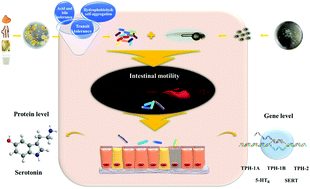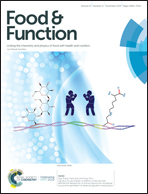Study of gastrointestinal tract viability and motility via modulation of serotonin in a zebrafish model by probiotics
Abstract
The relationship between bacterial strains and serotonin regulation was studied via the in vitro screening of the strains. Using the transparent visibility of zebrafish, the strains for intestinal peristalsis were quickly screened. The methods and results were as follows: (1) 18 strains with outstanding gastrointestinal viability via their surface hydrophobicity, self-aggregation ability, acid tolerance, bile tolerance, simulated gastric digestion and intestinal fluid tolerance were determined from 54 unpublished strains. (2) 5dpf zebrafish were randomly selected and divided into 22 groups with 12 tails in each group. The intestinal peristalsis frequency of each group within 1 min was calculated after immersing the model zebrafish in a 108 CFU mL−1 strain solution, with 5 effective strains obtained. (3) The serotonin in zebrafish was measured by Elisa and fluorescence immunization. The regulation mechanism of serotonin by Bifidobacterium animalis F1-7 was revealed by RT-PCR and the results show that this most effective strain promotes intestinal peristalsis in zebrafish via the modulation of serotonin release and key genes for serotonin synthesis in zebrafish.



 Please wait while we load your content...
Please wait while we load your content...